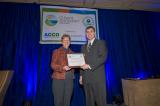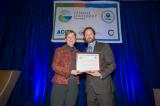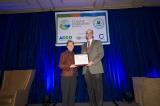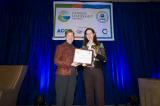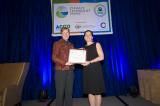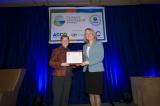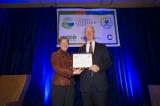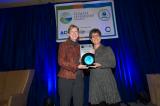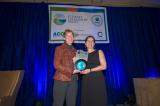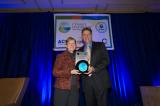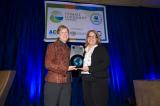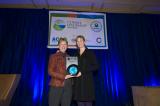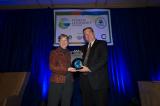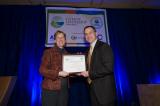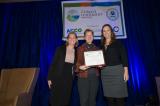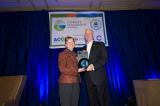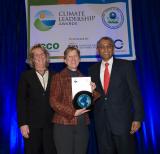2015 Climate Leadership Award Winners
 Congratulations to the 2015 Climate Leadership Award winners! One Individual, 14 Organizations, and two Partnerships were publicly recognized for their leadership in reducing greenhouse gas emissions during the awards dinner on February 24, as part of the Climate Leadership Conference, held in Arlington, VA from February 23 - 25, 2015.
Congratulations to the 2015 Climate Leadership Award winners! One Individual, 14 Organizations, and two Partnerships were publicly recognized for their leadership in reducing greenhouse gas emissions during the awards dinner on February 24, as part of the Climate Leadership Conference, held in Arlington, VA from February 23 - 25, 2015.
Read EPA's press release recognizing the awardees.
Organizational Leadership Award
Individual Leadership Award
Excellence in Greenhouse Gas Management (Goal Achievement Award)
- The City and County of San Francisco, California
- The Clorox Company
- DPR Construction
- SC Johnson
- Sprint
- UPS
Excellence in Greenhouse Gas Management (Goal Setting Certificate)
- Brown-Forman Corporation
- California Department of Water Resources
- Capital One Financial Corporation
- CH2M HILL
- The Clorox Company
- EMC Corporation
- The Hartford
- Tiffany & Co.
Innovative Partnerships Certificate
Special Thanks to the CLA Reviewers
Organizational Leadership Award
Recognizes organizations that not only have their own comprehensive greenhouse gas inventories and aggressive emissions reduction goals, but also exemplify extraordinary leadership in their internal response to climate change, through engagement of their peers, competitors, partners, and supply chain, and addressing climate risk in their enterprise strategies.
Bank of America
Headquartered in Charlotte, North Carolina, Bank of America is one of the world's largest financial institutions, serving individual consumers, small- and middle-market businesses and large corporations with a full range of banking, investing, asset management and other financial and risk management products and services in more than 40 countries.
Bank of America is receiving the Climate Leadership Award for Organizational Leadership. Highlights from its recent efforts include:
- Setting an absolute global greenhouse gas (GHG) reduction goal of 15 percent from 2010 levels through 2015. This goal builds on a previous total reduction of 18 percent of its U.S. GHG emissions from 2004-2009, set under the EPA's former Climate Leaders program. Its current GHG reduction goal was recognized in 2013 under the Goal Setting Category for this awards program, and under this goal, the company reduced Scope 1 and 2 GHG emissions by 19 percent through 2013.
- Becoming the first major U.S. bank to announce an environmental business initiative, which included a $20 billion commitment to financing efficiency, renewable energy, and other low-carbon projects. This 10-year plan was completed in fewer than six years and was renewed with a new commitment of an additional $50 billion. Bank of America developed methodologies to measure the environmental benefits of this environmental business initiative, including reductions in CO2 emissions, water use, and waste generation.
- Maintaining signatory status to the Carbon Principles (since 2008), which guide banks and its U.S. power industry clients in evaluating and addressing carbon risks related to financing of electric power projects.
- Issuing the first corporate green bond to fund energy efficiency projects in 2013. Bank of America worked extensively with other financial institutions and environmental groups to establish a voluntary set of guidelines to promote integrity in the development of the green bond market.
- Collaborating extensively with external stakeholders—corporate peers, universities, government leaders and other organizations to accomplish its climate change and environmental sustainability goals.
- Active involvement in numerous climate change related initiatives, including the Climate Markets & Investment Association, the United Nation's Green Climate Fund and Global Innovation Lab, and the Stanford University Global Climate and Energy Project. Bank of America has also demonstrated a leadership role in addressing policy issues, providing expertise to policymakers on issues such as prospective renewable energy finance policies.
- Establishing and implementing environmental sustainability goals from 2012 to 2015 including: reduction in energy, global water and paper consumption; increasing LEED certification in the company's corporate workplace portfolio; sourcing 100 percent of paper from certified sustainable forests; and diversion of global waste from landfills.
Bank of America's climate initiatives feature robust efforts toward internal/external engagement, strong governance within the company and aggressive reduction strategies.
Individual Leadership Award
Recognizes individuals who demonstrate extraordinary leadership both in their internal response to climate change and through engagement of their peers, competitors, partners, and supply chain.
Mayor Bill Finch, City of Bridgeport, Connecticut
Bill Finch was first elected as Mayor of Bridgeport, Connecticut in 2007 and was re-elected in 2011. Bridgeport is the most populous city in the state of Connecticut and provides government services for nearly 150,000 residents along with its businesses and other organizations.
Previously, Mayor Finch held elected office as a Bridgeport City Councilman for nearly a decade and later as a State Senator for Connecticut's 22nd senatorial district where he served as the Senate Chairman of the Environmental Committee, Vice-Chairman of the Transportation Committee, and Majority Whip.
Mr. Finch's priorities as Mayor include promoting energy initiatives, enhancing sustainability efforts and making Bridgeport, CT one of the greenest cities in America. Currently, Mayor Finch is Co-Chair of the U.S. Conference of Mayors Energy Independence and Climate Change Task Force.
Mayor Finch is receiving the Climate Leadership Award for Individual Leadership. Highlights from his recent efforts include:
- Implementing reduction efforts in support of the absolute GHG emission reduction goal he established for the City of 10 percent below 2007 levels by 2020.
- Forming a public-private partnership with the Bridgeport Regional Business Council to develop a comprehensive sustainability plan. This initiative assembled more than 100 stakeholder organizations. The BGreen 2020 Sustainability Plan established through this collaboration is a "greenprint" that encompasses more than 60 sustainability projects, including: green job creation, new green businesses, new green energy initiatives such as a 16-acre solar photovoltaic array on a landfill in partnership with a local utility, and turning under-performing brownfields into new parks.
- Bringing to the City the Dominion Bridgeport Fuel Cell, the largest fuel cell in North America that produces 14.9 megawatts of clean energy that efficiently converts natural gas into electricity.
- Encouraging United Illuminating to construct a solar array and fuel cell, as well as PSEG Power Connecticut to convert its Bridgeport coal-fired power plant to a cleaner-burning gasified electric power plant.
- Launching a micro-grid energy program with state assistance.
- Installing natural gas micro-turbines owned and operated by the City in the downtown area that will allow the City to provide essential services to residents in the event of power outages or weather emergencies.
- Advocating a public-private partnership for the installation of a thermal loop that will utilize geothermal energy to heat and cool buildings in downtown Bridgeport.
- Establishing the Energy Improvement District to promote green energy activities in the local business sector, and encouraging continued development of the Eco-Industrial Park in Bridgeport, which serves as a private investment incubator district that attracts green businesses and industries to the city.
- Organizing an annual Earth Day Expo where the City, private businesses, and NGOs highlight their environmental initiatives. Mayor Finch also participates in training inner-city youth recruits for the Mayor's Conservation Corps, which canvasses and provides information to low-income residents on energy improvement and conservation options.
- Working on creating climate resilient solutions for the coastal community's under-served residents; and
- Introducing electric vehicles into the City's fleet and installing publicly accessible charging stations.
Mayor Finch has been a community and organizational leader in driving meaningful climate action within the Greater Bridgeport community and throughout the City's operations.
Excellence in Greenhouse Gas Management (Goal Achievement Award)
Recognizes organizations that publicly report and verify organization-wide greenhouse gas inventories and achieve publicly-set aggressive greenhouse gas emissions reduction goals.
The City and County of San Francisco, California
San Francisco's commitment to sustainability continues alongside a growing population and economy. The City strives to meet its climate challenge and continues to surpass international and California emissions reduction targets established as part of the Kyoto Protocol and California's climate law, AB 32, while saving residents money, improving their health, addressing equity, and creating jobs.
San Francisco is being recognized for Excellence in Greenhouse Gas Management—Goal Achievement—for the following accomplishments:
- In 2002, the Mayor and Board of Supervisors passed Resolution 158-02 setting greenhouse gas emissions reductions including a community-wide reduction goal of 20 percent below 1990 levels. In 2012, the City's GHG emissions were 23 percent below 1990 levels, resulting in an absolute reduction of 1.4 million metric tons of CO2e, surpassing the original goal.
- The City and its partners achieved emission reductions through a variety of initiatives and the support of residents and the business community, including: improvements in fuel efficiency, increased use of hybrid and electric vehicles, and increased efficiency in transit fleets; cleaner commercial energy portfolio plus improvements in the energy mix for Direct Access customers, resulting in a 43 percent reduction in the carbon intensity of customers' electricity use; continued residential and commercial diversion of recyclable and organic material from the landfill; and energy programs for private sector commercial and residential buildings.
The Clorox Company
The Clorox Company is a multinational manufacturer and marketer of consumer household products headquartered in Oakland, California. Its products are manufactured in over two dozen countries and sold in more than 100 countries. Approximately 80 percent of operations/sales are generated in the U.S.
The Clorox Company is being recognized for Excellence in Greenhouse Gas Management—Goal Achievement—for the following accomplishments:
- Clorox announced its first public GHG reduction goal with the EPA's former Climate Leaders program to reduce global GHG emissions by 10 percent per case of product sold from 2008 to 2013. Clorox exceeded this goal in 2011, reducing its absolute global GHG emissions by 16 percent, and subsequently created a new public goal (from 2012 to 2020) for which it is also being recognized this year in the Greenhouse Gas Management—Goal Setting category.
- The Clorox Company achieved its GHG emission reductions by conducting lighting retrofits and energy audits at North America and Latin America facilities to optimize the efficiency of their operating equipment, air compressor, and HVAC systems. Clorox also increased efficiency of product distribution by transitioning from truck to rail (30 percent), and as an EPA SmartWay program partner, uses qualified carriers for more than 95 percent of its truck freight miles. The company has reduced business travel by more than 20 percent and converted employee-leased cars to hybrids.
DPR Construction
DPR Construction is a national commercial general contractor and construction management company that drives sustainability throughout its business and the industry. DPR Construction specializes in technically complex and sustainable projects for the advanced technology/mission critical, life sciences, healthcare, higher education, and corporate office markets.
DPR Construction is being recognized for Excellence in Greenhouse Gas Management—Goal Achievement—for the following accomplishments:
- DPR announced its first public GHG reduction goal to reduce combined GHG emissions per employee by more than 25 percent from 2007 levels through 2015 under the EPA's former Climate Leaders program. DPR achieved its GHG intensity reduction goal in 2011. By 2013, DPR reduced GHG emissions per employee by more than 31 percent, which also resulted in a 4 percent reduction in absolute emissions for the company since 2007.
- DPR achieved its emission reductions by acquiring real estate and retrofitting existing buildings to reduce energy consumption in regional office operations. These renovations resulted in a 30 percent reduction in Scope 1 & 2 emissions directly related to company facilities. Additionally, DPR developed and implemented staff incentives and benefits programs to encourage mass transit and carpooling. Further reductions in employee commute emissions came in the form of more efficient vehicles (both company and personal), changed driving and commuting habits, and changes in conventional operations (e.g., video teleconferencing).
SC Johnson
SC Johnson is a leading manufacturer of household cleaning products and products for home storage, air care, pest control, and shoe care. Based in Racine, Wisconsin, the fifth-generation family-owned company employs nearly 12,000 people globally and sells products in virtually every country around the world.
SC Johnson is being recognized for Excellence in Greenhouse Gas Management—Goal Achievement—for the following accomplishments:
- The company set and exceeded its absolute GHG reduction goal of 7 percent from 2011 to 2016, achieving absolute reduction in GHG emissions of nearly 17 percent in 2014 (based on 2010 baseline year).
- SC Johnson achieved its GHG emission reductions through increased use of renewable energy. In 2008, the company secured a source of wind power for nearly half of the electricity required to run its Bay City, Michigan factory. In 2013, SC Johnson increased its wind power purchases by 50 percent, which, along with the original purchasing agreement, resulted in a total reduction of 42,000 metric tons of greenhouse gas emissions per year. Also, in 2012, SC Johnson started up two 415-foot wind turbines at the company's largest global manufacturing facility in Mt. Pleasant, Wisconsin, which produce about 8 million kilowatt hours (kWh) of electricity annually.
SC Johnson previously set an indexed goal of 23 percent from 2000 to 2005 and an absolute goal of 8 percent from 2005 to 2010 with the EPA's former Climate Leaders program. The company exceeded both goals. Since 2000, when SC Johnson established its greenhouse gas emissions benchmark, the company has reduced its GHG emissions by 40 percent.
In 2012, SC Johnson received a Climate Leadership Award in Excellence in GHG Management (Goal Achievement Award) category.
Sprint
Sprint offers a comprehensive range of wireless and wireline communications services for nearly 56 million customers. Headquartered in Overland Park, Kansas, approximately 80 percent of Sprint's GHG emissions come from the operation of its networks. Other emission sources include office buildings, data centers, and retail stores.
Sprint is being recognized for Excellence in Greenhouse Gas Management—Goal Achievement—for the following accomplishments:
- Sprint set and exceeded its absolute GHG reduction goal of 20 percent from 2007 to 2017, achieving absolute reduction in GHG emissions of 29 percent in 2013. Sprint's initial GHG reduction goal was 12 percent in 2008 under the EPA's former Climate Leaders program, which the company subsequently increased to 15 percent in 2010 before setting its current goal—all with 2007 as the baseline.
- Sprint achieved its GHG emission reductions by redesigning its networks to reduce electricity consumption; its IT department has decreased its electricity use by 28 percent while increasing the number of new data centers. Sprint also implemented Building Automation Systems (BAS) to monitor heating and cooling activities which resulted in lowered electricity costs, reduced HVAC and lighting maintenance costs, and increased worker productivity (comfortable work environment).
In 2014, Sprint received two Climate Leadership Awards in the Organizational Leadership and Supply Chain Leadership categories.
UPS
UPS is a global leader in logistics, offering transporting packages and freight; facilitating international trade and deploying advanced technology to more efficiently manage the world of business. Headquartered in Atlanta, Georgia, UPS serves more than 220 countries and territories worldwide.
UPS is being recognized for Excellence in Greenhouse Gas Management—Goal Achievement—for the following accomplishments:
- In 2011, UPS set a goal to reduce its carbon intensity from transportation 10 percent by 2016 (from a 2007 baseline). UPS surpassed this goal in 2012 and 2013, achieving a 12 percent and 13 percent reduction, respectively. This goal also helped drive a 774,000 metric tonne decrease in absolute Scope 1 and 2 emissions from 2007 to 2013.
- UPS achieved its carbon intensity goal by executing its global greenhouse gas reduction strategy, which includes operating a single, optimized global network; employing intermodal shifting to provide customers with low-carbon transportation options; investing continuously in innovative solutions to minimize miles driven and flown; and working with drivers and pilots to ensure precision performance.
UPS initially set a global goal in 2010 of a 5 percent carbon intensity reduction below 2007 levels by 2017 with the EPA's former Climate Leaders program. UPS exceeded this goal with an 8 percent reduction in carbon intensity in 2011.
In 2012, UPS received a Climate Leadership Award in the Supply Chain Leadership category.
Excellence in Greenhouse Gas Management (Goal Setting Certificate)
Recognizes organizations that publicly report and verify organization-wide greenhouse gas inventories and publicly set aggressive greenhouse gas emissions reduction goals.
Brown-Forman Corporation
Founded in 1870 in Louisville, Kentucky, Brown-Forman is one of the largest American-owned spirits and wine companies and among the top 10 largest global spirits companies, selling its brands in approximately 160 countries. Brown-Forman has more than 25 brands in its portfolio of wines and spirits, and employs more than 4,200 people worldwide.
Brown-Forman is being recognized for Excellence in Greenhouse Gas Management—Goal Setting—for the following accomplishments:
- Brown-Forman set an absolute GHG reduction goal of 15 percent between 2012 and 2022 for global operations.
- Brown-Forman plans to achieve its reduction goal by switching from fossil fuel to biomass in its steam boilers at distillation operations; changing the processing of byproducts from grain distillation operations to reduce energy consumption; and switching steam boiler fuel to a less GHG-intensive fossil fuel at one production operation.
Previously, the company's first generation goal was intensity based—30 percent metric tons CO2e per unit ton of production from 2009 by 2020. This was realized early in 2012 with a 46 percent reduction.
California Department of Water Resources
The California Department of Water Resources (DWR) operates and maintains hundreds of miles of flood protection levees and structures, provides water planning for California, administers over $1 billion in grant funds for improvements to local water resources, and provides regulatory oversight of dams statewide. DWR also manages the California State Water Project (SWP), which generates 98 percent of DWR's emissions and is the single largest user of electricity in the state (energy is used to pump and deliver water to water users).
DWR is being recognized for Excellence in Greenhouse Gas Management—Goal Setting—for the following accomplishments:
- DWR set an absolute GHG reduction goal of 33 percent between 2010 and 2020 for U.S. operations.
- DWR plans to achieve its reduction goal in several ways, including procuring renewable energy to run the SWP; replacing coal power with cleaner, less GHG-intensive sources; and increasing the energy efficiency of pumps and turbines throughout the SWP system.
DWR's first generation GHG emissions goal in 2010 was a 50 percent reduction by 2020 and 80 percent reduction by 2050 (both with a 1990 baseline). DWR is being recognized for setting an interim goal, still maintaining the same absolute emissions goals for 2020, but setting a new verified baseline at 2010 emissions levels.
Capital One Financial Corporation
Capital One Financial Corporation is a financial holding company headquartered in McLean, Virginia. Capital One offers a broad spectrum of financial products and services to consumers, small businesses, and commercial clients through a variety of channels.
Capital One is being recognized for Excellence in Greenhouse Gas Management—Goal Setting—for the following accomplishments:
- Capital One set an absolute GHG reduction goal of 25 percent between 2013 and 2020 for global operations.
- Capital One plans to achieve its reduction goal through energy-efficient new office construction and building renovations; energy efficiency upgrades (e.g., Building Automation Controls, HVAC, LED lighting); and increasing purchases of renewable energy certificates (RECs)—approximately 10 percent of the company's current total electricity usage comes from renewable energy sources.
Capital One achieved its first generation goal in 2012, meeting its absolute reduction target of 10 percent based on a 2008 baseline.
CH2M HILL
Employee-owned CH2M HILL is a global consulting, design, design-build, operations, and program management company with 25,000 employees worldwide, working in areas of energy, water, environment, and infrastructure to design integrated solutions.
CH2M HILL is being recognized for Excellence in Greenhouse Gas Management—Goal Setting—for the following accomplishments:
- CH2M HILL set an absolute GHG reduction goal of 25 percent between 2012 and 2017 for global operations.
- CH2M HILL plans to achieve its reduction goal through a facilities management plan that includes reducing energy consumption and GHG emissions for vehicles and buildings at its most energy-intensive project site; improving efficiency of four LEED-certified headquarter buildings, which are also ENERGY STAR certified; and implementing office behavior-based energy conservation programs.
This is the company's first reduction goal encompassing its global, company-wide Scope 1 and 2 footprint. In past years, however, CH2M HILL has communicated goals for emissions reductions associated with business travel, North American facilities energy use, and various Scope 3 initiatives.
The Clorox Company
The Clorox Company is a multinational manufacturer and marketer of consumer household products headquartered in Oakland, California. Its products are manufactured in over two dozen countries and sold in more than 100 countries. Approximately 80 percent of operations/sales are generated in the U.S.
The Clorox Company is being recognized for Excellence in Greenhouse Gas Management—Goal Setting—for the following accomplishments:
- Clorox set both intensity and absolute GHG reduction goals of 20 percent between 2011 and 2020 for global operations.
- Clorox plans to achieve its reduction goals through energy efficiency projects (lighting retrofits and energy audits at all North America and Latin America facilities); moving finished goods distribution from truck to rail and continuing to use qualified EPA SmartWay carriers for more than 95 percent of truck freight miles; and reducing workplace energy use, including reduced business travel.
This is the company's second generation GHG emissions reduction goal. In 2007, under the EPA's former Climate Leaders program, Clorox set a goal to reduce global GHG emissions by 10 percent per case of product sold by 2013. The company met and exceeded this goal in 2011 with 16 percent emissions reductions.
EMC Corporation
EMC Corporation is a leading Information Technology (IT) company whose mission is to lead businesses and service providers to transform their operations and deliver IT as a service. EMC enables customers to move to cloud computing, gain value through analysis of Big Data and to do so within a trusted computing environment. Headquartered in Hopkinton, Massachusetts, EMC employs more than 65,000 people worldwide with corporate locations in 75 countries.
EMC Corporation is being recognized for Excellence in Greenhouse Gas Management—Goal Setting—for the following accomplishments:
- EMC set an absolute GHG reduction goal of 40 percent between 2010 and 2020 for global operations.
- EMC plans to achieve its reduction goal through a highly-efficient infrastructure at company-owned and large leased facilities including labs, data centers, and manufacturing floors; employing its leading-edge technologies to use the entire IT infrastructure more efficiently; and obtaining 50 percent of its global electricity from renewable sources by 2040.
Previously, EMC achieved its goals to reduce global Scopes 1 & 2 GHG emissions per unit revenue by 30 percent (2005 to 2012) and subsequently by 40 percent (2005 to 2015). EMC has also set long-term goals to reduce global absolute Scopes 1 & 2 emissions by 80 percent from 2000 to 2050.
The Hartford
With more than 200 years of expertise, The Hartford is one of the largest providers of property and casualty insurance, group benefits, and mutual funds in the U.S. Headquartered in Hartford, Connecticut, The Hartford has approximately 18,800 employees.
The Hartford is being recognized for Excellence in Greenhouse Gas Management—Goal Setting—for the following accomplishments:
- The Hartford set an absolute GHG reduction goal of 20 percent between 2013 and 2018 for global operations.
- The Hartford plans to achieve its reduction goal through energy efficiency upgrades—HVAC system, technology for virtual participation and paperless meetings, more efficient office spaces, and green technology embedded in the elevators; re-evaluating real estate footprint; converting 15 percent of vehicle fleet to hybrids; using cloud technology projected to reduce data center GHG emissions by more than 30 percent; and growing use of online meetings, thereby decreasing staff commuting and business travel.
This is The Hartford's third generation GHG emissions reduction goal. The Hartford achieved its first goal to reduce global greenhouse gas emissions by 15 percent in 2010—seven years ahead of schedule. The Hartford exceeded its second goal to reduce global greenhouse gas emissions by 20 percent in 2012—five years ahead of schedule. The Hartford was recognized with a Climate Leadership Award for Excellence in Greenhouse Gas Management—Goal Achievement in 2014.
Tiffany & Co.
Tiffany & Co. operates jewelry stores and manufactures products through its subsidiary corporations. Its principal subsidiary is Tiffany and Company. The Company operates TIFFANY & CO. retail stores in the Americas, Asia-Pacific, Japan, Europe, United Arab Emirates, and Russia. As of October 2014, Tiffany operated 294 stores in 25 countries.
Tiffany & Co. is being recognized for Excellence in Greenhouse Gas Management—Goal Setting—for the following accomplishments:
- Tiffany & Co. set an absolute GHG reduction goal of 15 percent between 2013 and 2020 for global operations.
- Tiffany & Co. plans to achieve its reduction goal through energy efficiency improvements—efficient lighting systems such as LED strips in retail stores, upgrading heating, ventilation and air conditioning (HVAC) systems, and installing submeters at sites that are not currently metered; new stores and facilities built with energy efficient building systems; and expanding its renewable energy portfolio.
This is Tiffany's second generation GHG emissions reduction goal. Under the EPA's former Climate Leaders program, the company established a goal of reducing U.S. GHG emissions by 10 percent per square foot from 2006 to 2011, and exceeded this goal, resulting in a Climate Leadership Award for Excellence in Greenhouse Gas Management—Goal Achievement in 2013.
Innovative Partnerships Certificate
Recognizes organizations working collaboratively on leading edge climate initiatives. Partnerships have collectively established objectives to measurably address greenhouse gas reduction goals and/or adaptation and resilience.
Chevrolet Clean Energy Campus Campaign
The Chevrolet Clean Energy Campus Campaign provides funding to purchase and retire carbon reductions from clean energy efficiency projects on U.S. college and university campuses. The partnership created a methodology enabling campuses to draw upon a new source of funding—carbon credit from the carbon market—to help colleges and universities invest in more energy efficient technologies.
The Clean Energy Campus Campaign is being recognized for a Climate Leadership Award—Innovative Partnerships Certificate—for the following accomplishments:
- This partnership created a way for colleges and universities to bring the benefits of GHG reductions to their own campus and communities in order to drive deeper energy efficiency and clean energy gains on campuses. Top-performing schools that surpass the methodology's performance benchmarks for energy leadership are able to measure and sell their GHG reductions as certified carbon credits, and utilize the revenue toward funding new efficiency and clean energy projects on campus—driving greater GHG reduction gains in the future.
- This partnership marks the first time college campuses have been able to use carbon performance methodologies to earn revenue via GHG reductions that result from on-campus efficiency and clean energy.
- The Campaign set a 100 percent absolute GHG reduction goal through 2014 (2012 base year). Six hundred and seventy five campuses made a long-term pledge to become carbon neutral through the American College and University Presidents' Climate Commitment. The Campaign engaged the top-performing leaders within this group.
- The Campaign has engaged hundreds of stakeholders spanning the education, energy, carbon, auditing, and nonprofit sectors. More than 60 stakeholders, for example, were engaged in developing the methodology. Hundreds of campus leaders have learned about the program through webinars, conference workshops, and conference calls. Dozens of students have not only attended clean energy innovation workshops through the campaign, but have also successfully engaged their campus leaders to secure funding.
Primary stakeholders include:
- Chevrolet/General Motors
- Eleven colleges including Ball State University, Boston University, Grand Valley State University, Portland State University, Rochester Institute of Technology, Southern Oregon University, Spelman College, University of Illinois at Chicago, University of Illinois at Urbana-Champaign, University of Wisconsin - Stevens Point, and Valencia College.
- American College and University Presidents' Climate Commitment (ACUPCC) - managed by Second Nature
- Association for the Advancement of Sustainability in Higher Education (AASHE)
- Bonneville Environmental Foundation
- Climate Neutral Business Network
- Det Norsk Veritas
- U.S. Green Building Council
- Verified Carbon Standard
San Diego Regional Climate Collaborative
The San Diego Regional Climate Collaborative is a member-based network that supports San Diego public agencies in advancing solutions to increase energy efficiency, reduce greenhouse gas emissions, and prepare for climate impacts. The Climate Collaborative builds partnerships between local government and businesses, academia, non-profits, and philanthropic entities to share expertise, leverage resources, and advance actions that benefit the San Diego region's communities, economy, and natural resources.
The San Diego Regional Climate Collaborative is being recognized for a Climate Leadership Award—Innovative Partnerships Certificate—for the following accomplishments:
- Establishing a Climate Collaborative Network that engages public agencies and stakeholders regarding climate change strategies and lessons learned from state and regional projects. This innovative collaboration works to make available to a broad audience valuable information from California State agencies about state climate policy developments, tool developers with new GHG or sea-level rise modeling tools, funding opportunities, and other resources.
- The Climate Collaborative supports members in setting and meeting GHG reduction targets via trainings and information on GHG inventory and monitoring tools; sharing Climate Action Plan templates; supporting local governments in developing Climate Action Plans; developing capacity for local governments to implement measures in their Climate Action Plans; and more.
- The Climate Collaborative is successfully building capacity for public agency staff to undertake actions to increase energy efficiency and address climate change. This involves assistance with grant applications, managing an AmeriCorps program to support local government climate change projects, providing trainings and workshops, and serving as a coordinator for case studies, models and best practices.
- This collaborative partnership has successfully supported pilot projects that seek to integrate climate change preparedness into regional-scale policies or plans, such as the San Diego County Hazard Mitigation Plan Update project.
- This partnership is a replicable model for other regions, and has significant public engagement and stakeholder outreach.
The Climate Collaborative members include:
- City of Chula Vista
- City of Encinitas
- City of Oceanside
- City of San Diego
- CleanTech San Diego
- County of San Diego
- Port of San Diego
- San Diego Association of Governments
- The San Diego Foundation
- San Diego Gas & Electric
- San Diego Regional Airport Authority
- San Diego State University Center for Regional Sustainability
- Tijuana River National Estuarine Research Reserve
- University of San Diego
Climate Leadership Awards Steering Committee
- Timothy Juliani, Center for Climate and Energy Solutions (C2ES)
- Jennifer Kaminski, The Climate Registry
- Melissa Klein, U.S. EPA
- Daniel Kreeger, Association of Climate Change Officers
- Katie Mandes, Center for Climate and Energy Solutions (C2ES)
- Philip Santiago, Association of Climate Change Officers
Special Thanks
The Climate Leadership Awards Steering Committee would like to thank the following individuals for their dedication to and support of the program:
2015 Application Reviewers
- Matthew Banks, WWF Climate Savers
- Keith Canfield, HEAL, Clinton Foundation
- Peggy Foran, The Climate Registry
- Amy Hargroves, Sprint
- Bruce Klafter, Flextronics
- Michele Madia, Second Nature
- Susan Mazur-Stommen, Indicia Consulting
- Michael Mondshine, WSP
- Margery Moore, Bloomberg BNA
- Valerie Patrick, Fulcrum Connection LLC
- Cara Pike, Climate Access
- Gene Rodrigues, ICF International
- John Sottong, U.S. EPA
- Susan Wickwire, U.S. EPA
- Emma Zinsmeister, U.S. EPA
- Kathryn Zyla, Georgetown Climate Center
About the Awards
The awards distributed were produced by Rivanna Natural Design using Black Diamond Richlite and 100% postconsumer glass. Richlite is an FSC-certified natural fiber composite. Richlite is also GREENGUARD certified for indoor use in residential, school and institutional environments.

